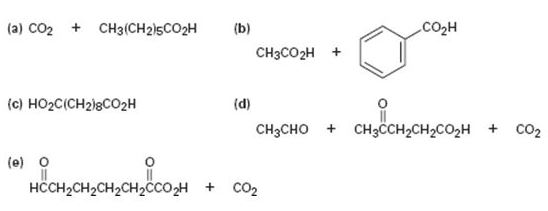
EBK ORGANIC CHEMISTRY
9th Edition
ISBN: 9780100591318
Author: McMurry
Publisher: YUZU
expand_more
expand_more
format_list_bulleted
Concept explainers
Textbook Question
Chapter 9.SE, Problem 34AP
Propose structures for hydrocarbons that give the following products on oxidative cleavage by KMnO4 or O3:

Expert Solution & Answer
Trending nowThis is a popular solution!

Students have asked these similar questions
Construct a molecular orbital diagram for carbon monoxide. Identify the relevant point group,include all of the appropriate symmetry labels and pictures, and fill in the electrons. Make sure toaccount for the difference in electronegativity between C and O. Hint: CO is substantiallyisoelectronic to N2. (PLEASE DRAW THE ENTIRE MO DIAGRAM!!!)
please help with hw
help me solve this hw
Chapter 9 Solutions
EBK ORGANIC CHEMISTRY
Ch. 9.1 - Prob. 1PCh. 9.1 - Prob. 2PCh. 9.3 - What products would you expect from the following...Ch. 9.4 - Prob. 4PCh. 9.4 - Prob. 5PCh. 9.4 - Prob. 6PCh. 9.4 - Prob. 7PCh. 9.5 - Using any alkyne needed, how would you prepare the...Ch. 9.7 - The pKa of acetone, CH3COCH3, is 19.3. Which of...Ch. 9.8 - Prob. 10P
Ch. 9.8 - Prob. 11PCh. 9.9 - Show the terminal alkyne and alkyl halide from...Ch. 9.9 - Beginning with acetylene and any alkyl halide...Ch. 9.SE - Name the following alkynes, and predict the...Ch. 9.SE - From what alkyne might each of the following...Ch. 9.SE - Prob. 16VCCh. 9.SE - The following cycloalkyne is too unstable to...Ch. 9.SE - Prob. 18MPCh. 9.SE - Assuming that strong acids add to alkynes in the...Ch. 9.SE - Prob. 20MPCh. 9.SE - Prob. 21MPCh. 9.SE - Prob. 22MPCh. 9.SE - Prob. 23MPCh. 9.SE - Prob. 24MPCh. 9.SE - Reaction of acetone with D3O+ yields...Ch. 9.SE - Give IUPAC names for the following compounds:Ch. 9.SE - Draw structures corresponding to the following...Ch. 9.SE - Prob. 28APCh. 9.SE - Prob. 29APCh. 9.SE - Prob. 30APCh. 9.SE - Predict the products from reaction of l-hexyne...Ch. 9.SE - Prob. 32APCh. 9.SE - Prob. 33APCh. 9.SE - Propose structures for hydrocarbons that give the...Ch. 9.SE - Identify the reagents a-c in the following scheme:Ch. 9.SE - Prob. 36APCh. 9.SE - Prob. 37APCh. 9.SE - Prob. 38APCh. 9.SE - How would you carry out the following...Ch. 9.SE - Prob. 40APCh. 9.SE - Synthesize the following compounds using 1-butyne...Ch. 9.SE - Prob. 42APCh. 9.SE - Prob. 43APCh. 9.SE - Prob. 44APCh. 9.SE - Prob. 45APCh. 9.SE - A hydrocarbon of unknown structure has the formula...Ch. 9.SE - Compound A(C9H12) absorbed 3 equivalents of H2 on...Ch. 9.SE - Hydrocarbon A has the formula C12H8. It absorbs 8...Ch. 9.SE - Occasionally, a chemist might need to invert the...Ch. 9.SE - Prob. 50APCh. 9.SE - Prob. 51APCh. 9.SE - Prob. 52APCh. 9.SE - Prob. 53APCh. 9.SE - Prob. 54APCh. 9.SE - Prob. 55APCh. 9.SE - Prob. 56APCh. 9.SE - Prob. 57AP
Knowledge Booster
Learn more about
Need a deep-dive on the concept behind this application? Look no further. Learn more about this topic, chemistry and related others by exploring similar questions and additional content below.Similar questions
- Briefly explain chemical potential.arrow_forwardReason whether it is possible to determine changes in the Galvani potential difference at the metal-solution interface.arrow_forwardObtain the standard potential at 25°C of the Cu* I Cu | Pt electrode from the standard potentials E° Cu²+/Cu = 0.341 V and E Cu²+ /Cu+ = 0.153 V.arrow_forward
arrow_back_ios
SEE MORE QUESTIONS
arrow_forward_ios
Recommended textbooks for you

 Organic ChemistryChemistryISBN:9781305580350Author:William H. Brown, Brent L. Iverson, Eric Anslyn, Christopher S. FootePublisher:Cengage Learning
Organic ChemistryChemistryISBN:9781305580350Author:William H. Brown, Brent L. Iverson, Eric Anslyn, Christopher S. FootePublisher:Cengage Learning


Organic Chemistry
Chemistry
ISBN:9781305580350
Author:William H. Brown, Brent L. Iverson, Eric Anslyn, Christopher S. Foote
Publisher:Cengage Learning
Coenzymes and cofactors; Author: CH15 SWAYAM Prabha IIT Madras;https://www.youtube.com/watch?v=bubY2Nm7hVM;License: Standard YouTube License, CC-BY
Aromaticity and Huckel's Rule; Author: Professor Dave Explains;https://www.youtube.com/watch?v=7-BguH4_WBQ;License: Standard Youtube License